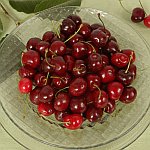|
|
 Cherry, the common name for several related trees, and for the edible fruit of
some species. The genus containing cherry trees also includes plums, peaches,
almonds, and apricots. Because many of these plants have been cultivated for
thousands of years and widely hybridized, the classification is complex.
Cherry, the common name for several related trees, and for the edible fruit of
some species. The genus containing cherry trees also includes plums, peaches,
almonds, and apricots. Because many of these plants have been cultivated for
thousands of years and widely hybridized, the classification is complex.
The ancestors of most of the modern cultivated varieties of cherry are probably
the sweet, or dessert, cherry and the sour, or pie, cherry. The sweet cherry
tree is frequently planted for its fruit and for its beauty when in flower,
and also for its value as a timber tree. It grows rapidly and has strong,
close-grained wood, suitable for use by cabinetmakers, turners, and
musical-instrument makers. Double varieties of both species are also grown.
Cherries are grown in many parts of the United States. Sweet cherries, more
difficult to grow, are cultivated mainly in California, and sour cherries are
common in the East. Some species with inferior fruit are cultivated especially
for their flowers. Most notable of these are the Oriental cherry and the
Nanking cherry. Thousands of trees of these species, presented by Japan to the
United States in 1912, have been planted in Washington, D.C., around the
Potomac Basin, where the cherry blossoms attract considerable attention
each year in April.
How to Store:
Cherries do not ripen after harvest. They are very perishable, so refrigerate
them immediately after purchase. Cherries can be kept fresh in the refrigerator
for up to two days.
Nutritional Facts:
· Fat-free
· Saturated fat-free
· Sodium-free
· Cholesterol-free
· A good source of fiber
Detailed nutritional informatin can be found by searching the
USDA Nutritional Database
. Enter "Cherry" (no quotes) as the keyword and select the link and report
of interest.
Scientific classification:
Cherry trees belong to the family Rosaceae. The sweet, or dessert, cherry is
classified as Prunus avium.
|
|